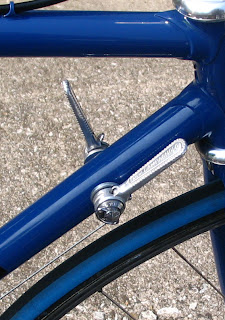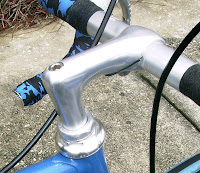Science Friction
 Mon, September 17, 2007
Mon, September 17, 2007 
My Techno-geek post last Monday was intended to be a tongue in cheek humorous piece; I didn’t mean to cause friction, or a shift in attitude.
However, it did draw a surprising number of comments, both for and against. Many of them raising some interesting and valid points.
Some brought up the safety issue. You can argue after the fact that having the gear levers on the handlebars is safer, but that is not why this type of shifting was developed. It came about because the MTB market brought people into cycling who did not know how to operate a friction shift.
A mountain bike is one that anyone can jump on and ride, but a road bike, even with all the modern amenities still requires a degree of skill to ride. If for no other reason than it goes faster, and handles quicker.
One comment asked if I had noticed how many new cyclists are on the road; I will agree this is a good thing. However, this also means there is a lot of inexperienced riders out there, and it is inexperience that causes riders to touch wheels and fall, not that they are riding one handed.
When I started cycling in the early 1950s, we reached down between our legs to operate the front derailleur. I never heard of anyone falling while doing this, it was no more difficult than reaching down for a water bottle. Yet these type of derailleurs are now known as suicide shifters.
Don’t get me wrong, I am not advocating we should go back to this type of equipment. However it seems we now live in an age where half the cycling population is hooked on single speed, fixed gear, and the other half swears by 10 speed, index shifting.
Surely, there is room in this mix for a few people like me, who have ridden with down-tube, friction shifting all our lives, and six gears is enough. When the supply of the old stuff runs out, I will have no choice but to switch, and I will do so before giving up riding. (I may even find I like it.)
The computer age has meant that products go from the design stage to actual product on the shelf in a far shorter time; robotics take over manufacture. There becomes less and less human involvement, and something is lost.
Frames were once built by craftsmen like myself and others, and there is a part of me in every frame I built. I also rode bikes and raced on them and learned a great deal along the way, a slow gathering of knowledge over many years.
Today with large corporations building bikes, there is not the same gathering of knowledge. Equipment is developed, and almost immediately becomes obsolete. Knowledge gathered is forgotten as they move on. Engineers who are not necessarily riders design bikes, and design is for the benefit of the manufacturer, not the consumer. Richard Sachs said it best when he stated, “The threadless steerer was an answer to a problem that didn’t exist.”
Richard Sachs said it best when he stated, “The threadless steerer was an answer to a problem that didn’t exist.”
The old style quill stem (Left.) worked fine, it was elegant and easy to adjust up and down. Now it is obsolete, not because it didn’t work, but because forks with threadless steering columns are easier to mass produce.
The quill stem was replaced with something ugly, in my opinion, and far from easy to adjust for height; sometimes you need to buy a whole new fork.
When I said, “Techno-geeks, keep your hands off my bike,” I was not putting down progress, but saying don’t discard everything good that has gone before.
Addendum:
When I said a mountain bike is easier to ride than a road bike I meant easier to ride on the road. I keep forgetting there are people who actually ride them off road; my apologies.
 Dave Moulton | Comments Off |
Dave Moulton | Comments Off | 

















Reader Comments (11)
How many people know that the most ferocious race car ever produced, the Porsche 917/30 was built almost 40 years ago (see Steve McQueen in Le Mans)? Or that Yo-Yo Ma plays a 270-year old cello? How many riders have even been on a 25-year old bike? Is it only connoisseurs that know, or care about these things?
Sometimes it is through blogs like yours that riders who are trying to ride well can learn. And something from the past can be new knowledge and useful to discerning riders.
I also plan on riding for life, on so many levels.
John B.
On shifting, I keep hearing that a rider should learn to master the art of shifting. Why? I just want it in an easier or harder gear. Click - there's my gear - keep riding. Can't say that my shifting comes out of adjustment very often. When it does, I use a skill that I believe is much more important and valuable to master: I know how to adjust my derailleur from the saddle using the barrel adjusters on the down tube. A quick twist and shifting's back in line. Again, not something that happens very frequently - maybe once or twice a season?
Stems: while I agree that the easy height adjustability of a quill stem is a nice feature, I do admire the mechanical simplicity of the threadless headset system. Seems like the argument everyone makes for the friction shifter: less parts to go wrong and lighter weight. Just about anyone can install and adjust a threadless stem with only a hex wrench, and how often do you need to adjust the stem height of a properly sized and fitted bike, anyway? Measure, set and forget, right?
Keep up the good work!
Good points you make, Dave. I too prefer the look of the old style quill stems.
It is up to each of us to take that as far and as serious as we want. And you will find plenty of anecdotal evidence to support whatever view you have, but if you aren’t out riding your bike, of what use is it?
Thirty years ago I didn’t think about riding a classic bike, just as I didn’t think much about winning my first race on a 1958 Bianchi Specialissima (in 1979). I also didn’t wish I had more gears, or a top-of-the-line bicycle. I was too busy trying to improve my form.
Today I enjoy riding “old technology” because I was raised with it, and I can; in that time we weren’t anticipating next year’s component changes because there weren’t any. If ‘old school’ invites someone to see certain parts of riding as a lost art, it isn’t the only one. At least this rolling art form was made to last a lifetime.
When I need to go fast, really fast, keep up on some competitive club climbs, I get my modern rocket down from the rafters, 'cause I know I'm gonna need all the help I can get.
On the other hand, If I want to have some retro-fun on a long group ride and know the hammering is going to be kept to a minimum, I'll pull down one of my vintage steeds.
My point is that I get bored riding the same-old same-old, and it's fun to mix it up. Yes, I love all my retro rides, friction shifting, tubular tires, steel frames, etc. But the newer stuff works good and rides well, too.
As far as the "easier" technology unleashing a hoard of inexperienced riders onto the roads: I got into lightweights around the time of the early '70's Bike Boom. Manufacturers here and abroad couldn't make 10-speeds fast enough to keep up with the demand. Some were excellent machines, others decent, lots of them were pretty shoddy. However, back then you could pick up a high-end bike with full Campy components for about $300 or less (I don't even think it was possible to spend over $500 for the most expensive bike). Nowadays, we're not talking hundreds of dollars; we're talking THOUSANDS of dollars. I don't see huge crowds at my LBS's lining up to drop six grand on a bike. If you check annual sales of road bikes in units, I don't think it comes even close to the 70's Boom.
Regarding stems: yeah, sculptural works of art. I can appreciate my Cinelli and vintage 3T stems. However, recently I had the awful task of sawing a completely frozen stem out of a steerer tube on a mid-80's Trek frame. Not fun! Extensive research on the internet indicates that the old style stems are inherently inefficient (only a small contact point for engaging the steerer tube) and they are prone to corrosion due to sweat, water, and crud dripping in between the stem and headset. Am I going to throw away all my cool old stems? No way, but I'm gonna make sure they're frequently greased
My point is: let's love our old rides and enjoy them, but we don't need to be Luddites about the new stuff either. And you can't convince me it's just as safe riding with one hand on the handlebars as it is with two.
I do admire the mechanical simplicity of the threadless headset system.
UNQUOTE
I think we all tend to rationalize in a way that argues in favour of whatever we have. We have a bike with a threadless stem system, we argue in favour of it. Look hard enough, and you can find advantages and disadvantages to just about anything.
I personally think that a threaded headset and corresponding stem is much more simple mechanically. For one thing, it's ludicrous that every time you adjust or change your stem, you end up having to adjust the headset too. It makes no sense whatsoever. So, that's my rationalization, and I'm sticking by it.
But even if the threadless system was mechanically superior, it's ugly as heck. It's a kludgy system at best.
Sure, you can say that people don't often adjust the height of their traditional stem once they have it set anyway. But similarly, you can't then turn around and say that an advantage of threadless is that there are lots of pop-front stems and so you don't have to remove handlebar tape and brake levers to swap the stem. To that, I could answer that once you have the stem you like, you also don't need to pop that front off to change it very often.
I would like to mention that the only other problem with quill stem is the lack of adjustment on a very small frame, and by small, I mean something like a 48cm frame;
http://i256.photobucket.com/albums/hh167/edscoble/quillstem.jpg
this is perhaps one of the only example of where threadless is a perfectly valid alternative.